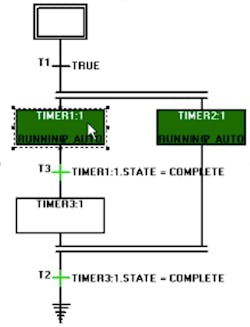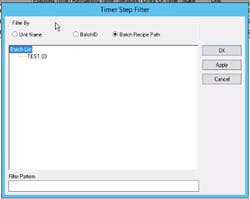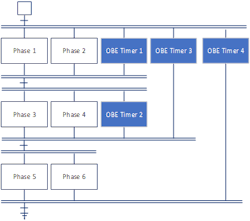Frequently, we hear new and seasoned engineers say they do not use the FactoryTalk Batch (FTBatch) standard timers ($timer) because they cannot interact with them or can't tell what the timer’s status is, as they can with controller-based timers.
Standard recipe timers require no design, implementation, testing, commissioning, nor validation as required by timer phases implemented in the controllers. Standard recipe $timers can be applied at all levels of the procedural model (procedures, unit procedures, and operations). Standard $timers can be used in as many places as required. Each instance of the timer is given a name defined by the recipe author that can be associated with the activity at hand. Timers are automatically added to the units configured on the area model just like the $Null phase.
Recipe timers come as standard functionality of the FTBatch recipe editor. Timers can be added to all levels of the recipes to track activities durations if configured in the count-up mode (timer 2 on fig. 1) or can be used in count-down mode to determine transition conditions to advance to other steps (timers 1 & 3 on fig. 1). The FTBatch timer’s status are visible and can be interacted with utilizing the standard "FactoryTalk Batch View HMI Controls."
This control is developed with the product and is off the shelf product functionality.
The timer view control provides an interface to view all the timer steps in batches currently on the batch list. You can configure filter criteria for the timer view control. You can also configure the behavior of the timer view control through the control’s property pages during design time. During run time you will have the ability to view their duration and remaining time status, as well as to change the setpoint value for COUNT_DOWN timers if the user has the credentials.
Users can filter the list to meet their needs.
Timer status can also be monitored and interacted with from the standard batch SFC view interface.
Timers can be used to track activities durations if configured in the count-up mode.
The duration can be specified in days, hours, minutes, or any combination of the three. The phase has a mode, which refers to the action it must take if the phase goes into the held state and then is restarted. The recipe author selects the mode based on the procedural requirements.
The TIMER phase modes are:
- Continue: If the phase goes into hold, the timer will continue to time. If the timer completes while the phase is in the held state, the phase will remain held. After the phase is restarted, if the timer has not timed out, the timer will continue timing until it completes. At this point the phase will complete as well. If the timer had completed while held, then the phase will complete as soon as it gets restarted.
- Retentive: If the phase goes into hold, the phase will stop the timer and the elapsed time is retained. After the phase is restarted, the timer will continue timing from the previously accumulated time until the timer completes. At this point the phase will complete.
- Reset: If the phase goes into Hold, the timer stops timing; the elapsed time is not retained, it is reset to zero (0). After the phase is restarted the timer starts from “0” and continues timing until it completes; at this point the phase will be completed.
Benefit from using standard recipe timers
Recipe timers come as standard functionality of the FTBatch recipe editor, not requiring design, implementation, testing or commissioning.
These timers can be added to all levels of the recipes to control activities durations if configured in the count-down mode and used as a transition conditions to advance steps.
The behavior of the timer during a recipe hold can be configured to continue timing, hold the count, or reset when restarting. This allows the recipe author to configure the behavior to better suit their needs.
The number of timers available are not limited and the timer class allows as many unique instances to be instantiated as required by the recipe author.
Timers are named with context relevance, these can easily be identified in the journals for reporting (i.e. duration for each manual activity or group of activities).
One could easily conclude that standard recipe timers ($Timer) can enhance the recipe authors ability to provide more recipe functionality as well as capture procedural information without requiring the implementation of controller-based timers. Standard recipe timers allow users complete visibility as well as control.
Randy Otto is CEO of ECS Solutions, a certified member of the Control System Integrators Association (CSIA). For more information about ECS Solutions, visit its profile on the CSIA Industrial Automation Exchange.About the Author
Randy Otto
CEO of ECS Solutions
Randy Otto is the CEO of ECS Solutions and brings more than 25 years of experience in diverse industries, including glass fibers manufacturing and custom assembly machine manufacturing. Before joining ECS, Randy spent 10 years managing the delivery of assembly equipment for Integrated Systems Manufacturing and process control systems for Premier System Integrators. For most of the last 12 years, he has managed business development and sales for ECS. Randy graduated from Purdue University with a degree in electrical engineering technology. He has an MBA from the University of Southern Indiana.

Leaders relevant to this article:




